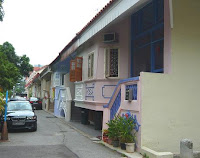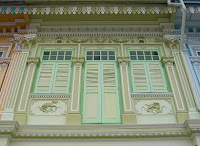Katong has always been associated with a larger area in eastern Singapore, including the quieter residential districts of Mountbatten, Telok Kurau, Siglap and Marine Parade. Joo Chiat is better known for its colourful rows of traditional Peranakan shophouses, dating back to the 1920s and 1930s, that line its narrow streets.
Today, Joo Chiat Road and East Coast Road are significant "spines' in Katong/Joo Chiat where the buzz and activity lie.
It does not matter whether it was Joo Chiat then Katong or Katong then Joo Chiat, more important is if you are here, remember to shop, eat and explore within this treasure trove of rich history, beautiful architecture and picture-perfect kopitiams, nonya foodstalls and multi-ethnic eateries.
I took the MRT, got off at Eunos Station and walked towards Changi Road. At the junction of Changi Road and Joo Chiat Road is the Joo Chiat Complex, where I started my walk.

^ Joo Chiat Complex (No. 1-2 Joo Chiat Road) is where you can find an intriguing array of Malay textiles and foodstuff.


^ Masjid Khalid (No. 130 Joo Chiat Road) was built in 1917 and recently renovated in 1998. The mosque was originally intended as a place of worship for Indian Muslims, and is today one of the gathering points of Katong/Joo Chiat's Malay community.

^ Eurasian Community House (No. 13 Ceylon Road). The Eurasion community has played an integral role in the history of Katong/Joo Chiat, with their unique blend of European and Asian culture.


^ St Hilda's Anglican Church (No. 83 Ceylon Road) was designed after a simple English parish church style. It features a conical tower built in the Victorian tradition. Today, the church has a tightly-knit community of parishioners, serving whole household from grandfather to their grand children.



^ Sri Sempaga Vinayagar Temple (No. 19 Ceylon Road) reflects Joo Chiat's eclectic mix of culture. Its history dates back to 1875, when an early Ceylonese Tamil pioneer built a small attap-hut like temple under a Senpaga tree, where a statue of the Lord Vinayagar (Elephant God) was said to be found. During WWII the temple was damaged but the main shrine remains intact and unscathed. The temple was later rebuilt with a 21-metre high Rajagopuram making it one of the tallest Indian temples in Singapore.
^ Nonya laska stalls along East CoastRoad. This is one of the stalls that sells laksa along this stretch of road. During lunch hour, tables and chairs spilled along the 5-foot way. Don't just enjoy the laksa, do take a look at the architecture of the building.
^ Former "Red House" Bakery (No. 75 East Coast Road). This former Katong Bakery & Confectionery, affectionately known "Red House" bakery, once famous for its swiss rolls and curry puff. It was originally built as a private residence facing the sea and operated as a bakery for over 80 years until its closure in 2003. The bakery was the first to bake 3-tier western-style wedding cakes in the 1920s. The building has been conserved and will remain a valuable part of Katong's heritage.
^ Former Joo Chiat Police Station, now Katong Village (86 East Coast Rd). This former Joo Chiat Police Station was built in 1928 to serve the burgeoning Joo Chiat community. The architectural style of this building is similar to many government buildings built at that time. Now, there are a few restaurants operating in this former police station.
^ The centre shophouse was the former Tay Buan Guan (TBG) shop, now Rumah Bebe (No. 113 East Coast Rd).
^ This shophouse is now occupied by Rumah Bebe (Bebe's House), a Peranakan arts and crafts store cum museum. You can try on a custom-made kebaya or a batik sarong, and catch an interesting beading demostration. You can also take Bebe's cooking class or buy ready-to-cook spices for some nonya-style meals back home.
^ The faint TBG print on the shopfront is the only sign of its once bustling former occupant, the Tay Buan Guan shop. The Tay Buan Guan department store grew from this humble shophouse to a multi-storey shopping centre located at the read of East Coast Road, and was one of Singapore's best-loved shopping hubs. Did you see the TBG print?
^ Katong Mall and the heritage marker with faded prints.
^ Joo Chiat Community Club (405 Joo Chiat Road) was once a humble wooden hut with simple facilities like a library, boy's club and basketball court. the Joo Chiat Community Club has since been extensively renovated. Today, it remains a meeting point for the community.
^ Former Joo Chiat Maternal and Child Health Clinic (No. 341 Joo Chiat Rd). Standing prominently opposite Marshall Lane, this former Joo Chiat Maternal and Child Health Clinic was established in 1907 to counter Singapore's high infant mortality rate. After WWII, the clinic began to focus on treating a nation devastated by the Japanese Occupation.
.
Feast your eyes on the exquisite architecture of these shophouses along Koon Seng Road. The colourful Peranakan culture and influence can be seen in the two rows of shophouses along Koon Seng Road. They are outstanding examples of Singapore's architectural heritage. The designs are exceptionally ornate and the details exquisite, showcasing a fusion of Eastern and Western influences.


^ the front facade of these shophouses
^ left: House No. 287 to 297 (orange) now under renovation
^ right: House No. 299 to 309 (blue) are occupied by Hotel 81
^ This is the other row of shophouses with exquisite architectural.
^ Kuan Im Tng Temple (No. 62 Tembeling Road). Built in 1921, this Chinese temple has been renovated twice. It plays a big role in the community life of Katong/Joo Chiat. Its ornate facade and front doors are flanked by circular windows, surrounded by yellow, white and blue mosaic symbols of the 8 immortals. The green roof tiles are Chinese-made and its roof ridges are adorned with status of dancing dragons with clestial pearl, symbolising prosperity and good fortune. The main prayer hall of the temple is dedicated to Guan Yin (Goddess of Mercy), Confucius and the Sun and Moon Gods.
^ Lotus at Joo Chiat (No. 89 to 103 Joo Chiat Place). Walk up Everitt Road to Joo Chiat Place to see an architectural masterpeice. The Lotus at Joo Chiat apartments are a fine example of integrating old shophouses with new flats and were built in the 1930s in the Late Shophouse style. This development received the URA's Architectural Heritage Award in 2002 for their excellent restoration.
^ Look at the narrow 5 foot way...
^ Conserved terrace houses (No 150B to 150T East Coast Road). These single storey terrace houses stand beside a former sea wall near where the beach used to be. What makes these homes unusual is that the living area is built on raised ground to protect the rising tides then. The architectural style is also unique, an eclectic mix of traditional local architecture infused with Western influence, seen in the elaborate fascia boards and decorative plaster motifs.
^ Church of the Holy Family (6 Chapel Rd). The Church of the Holy Family, a pre WWII parish church, was a focal point for the Eurasian community of Katong/Joo Chiat. Its origins date from 1902, with the original chapel built in 1923. The first Christmas mass held in Katong/Joo Chiat took place here in 1936. Today, it continues to serve the spiritual needs of the local Catholic community. The building was re-built in 1999, while the front sculptures have been retained from the original church structure.
^ Chin Mee Chin Confectionery (No 204 East Coast Rd). One of the last remaining Hainanese coffee shops of old, this popular confectionery retains an authentic 1950s ambience. Whet your appetite with the rich strong coffee hot kaya buns and yummy sugar rolls.
^ Katong Antique House (No. 208 East Coast Rd). The Katong Antique House is a veritable museum of Peranakan artefacts, showcasing family heirlooms and antiques collected by its genial owner, Mr Peter Wee. Make an appointment with Peter and let him regale you with sotries from his grandfather's days. Then marvel at intricately woven kasut manek or beaded slippers, charming furniture and wedding costums.
^ The Former Grand Hotel (No. 25 & 26 Still Road South). In 1917, Moona Kader Sultan, a wealthy Indian cattle merchant built the Karikal Mahal, or the Grand Hotel as it was later known. Originally a complex of four houses, the luxurious gardens were spilt into two with the construction of Still Road South has been gazetted for conservation. This grand dame remains a looker, retaining much of her Victorian splendour with charming turrets, ornate facade plaster decorations and breezy bay windows.
Side track...
^ House No. 1 to 25 Koon Seng Rd are gazetted for conservation.
^ Look at these beautiful exteriors...
^ this lane is just enough for a car to pass through...
^ left: this building is at the junction of Joo Chiat Rd and Crane Rd
^ right: shophouses along Onan Rd
^ left: this building is at the junction of Joo Chiat Rd & Marshall Lane





















































4 comments:
Wow..the pictures and description are great and very informative. I am interested in learning about Peranakan and I came across your blog. I also interested in collecting peranakan porcelain. Can you give me some tips on where to buy them (in joo chiat area or elsewhere)?
Hi Ester G, thanks for passing by. If you are in katong, you can take a look at Katong Antique House at 208 East Coast Rd or Kim Choo at 109 East Coast Rd. They have a variety of perankan items. Take some time to walk about, it's a amazing place. Thanks.
I enjoyed your blog and the photo of the red 3-storey shophouse at the corner of Joo Chiat Road and Marshall Lane caught my eye. I've passed it a few times and have often wondered what is was before and what is it now ?
Would appreciate if you could shed some light.
The building is under conservation by National Heritage Board. At that time, a restaurant was operating there. They were having their opening ceremony on that day.
Post a Comment